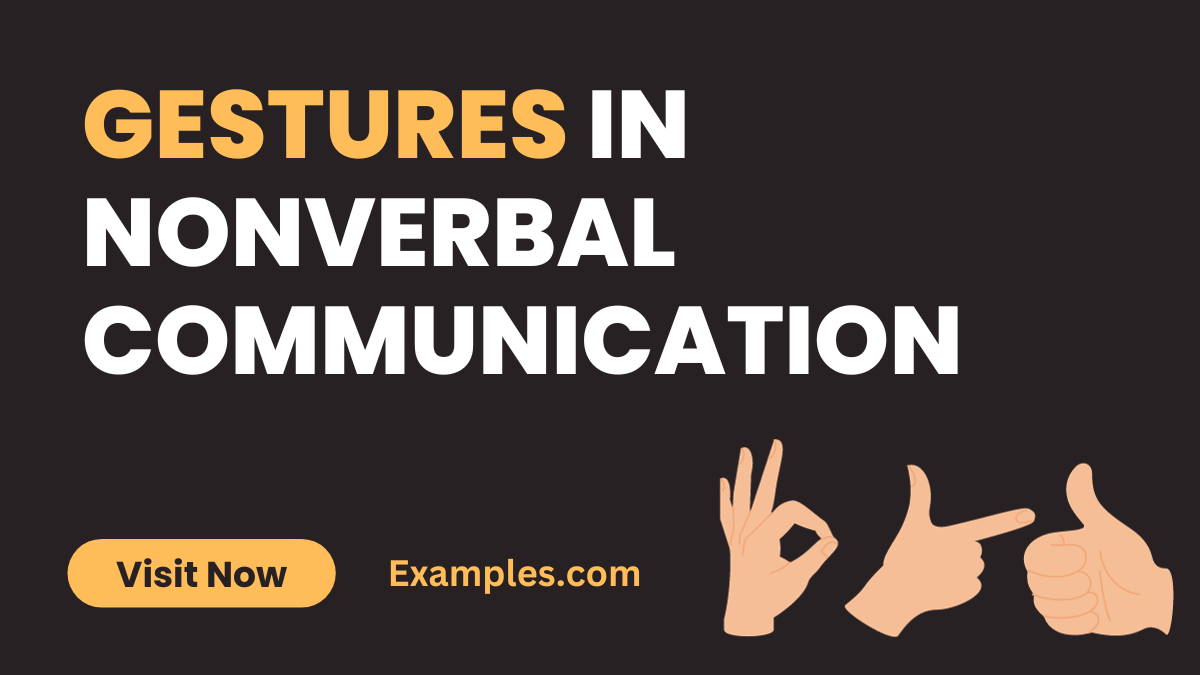30+ Gestures in Nonverbal Communication Examples
Understanding the role of gestures in nonverbal communication is pivotal in mastering effective interaction. This guide delves into various communication examples, illustrating how gestures can convey messages without spoken words. From the subtle nod to expressive hand movements, each gesture holds significant meaning in diverse contexts. By exploring different scenarios, this guide aims to equip readers with a profound comprehension of how gestures enhance and sometimes entirely carry the weight of communication.
What are Gestures in Nonverbal Communication?
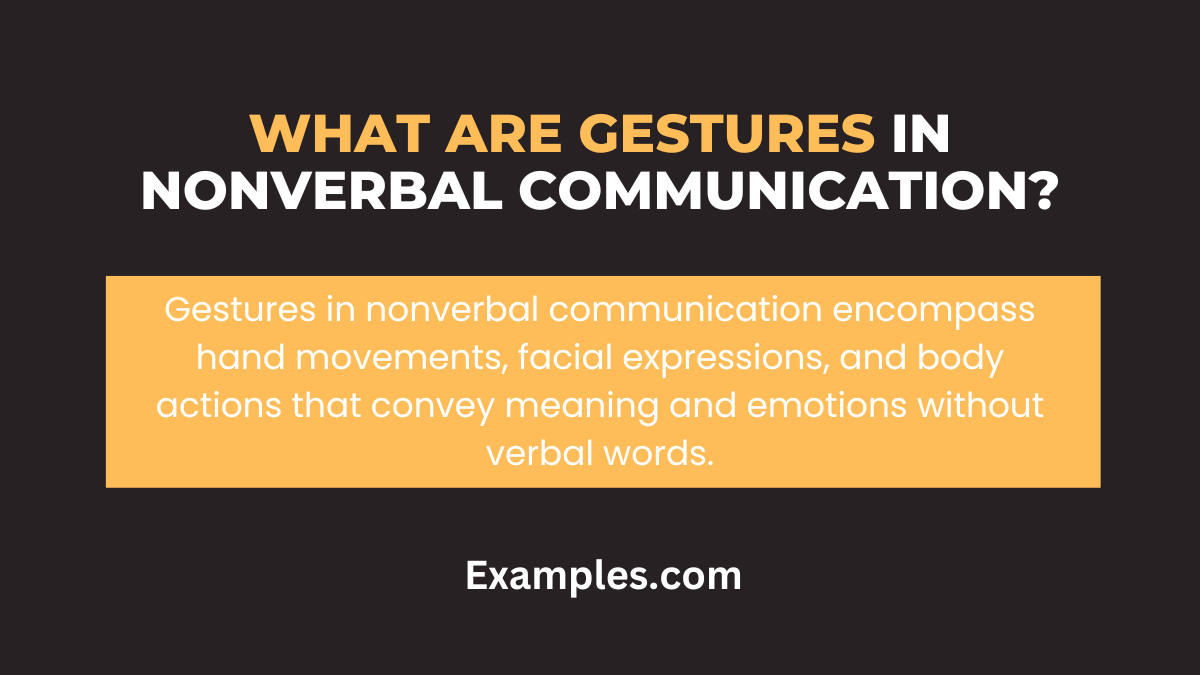
Gestures, a fundamental aspect of nonverbal communication, encompass any physical movement used to express an idea, emotion, or message without verbal articulation. They range from facial expressions, hand movements, to body posture, playing a crucial role in conveying messages in everyday interactions. Understanding gestures enriches communication, offering insights beyond spoken words.
What is the Best Example of Gestures in Nonverbal Communication?
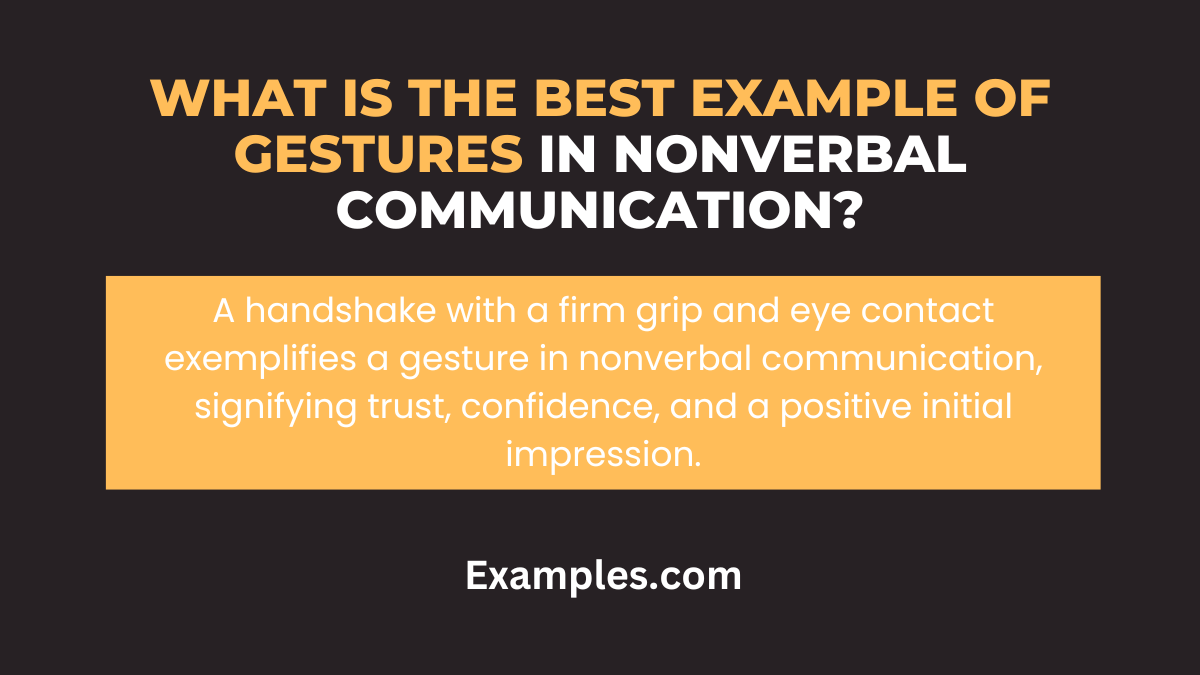
One of the best examples of gestures in nonverbal communication is the use of hand movements during a conversation. These gestures, ranging from pointing to illustrate a point to open palms indicating honesty and openness, significantly enrich the message being conveyed. Facial expressions also play a pivotal role, with a smile or frown providing immediate feedback or emotional context to the verbal communication. These gestures are universal in human interactions, making them essential tools for effective communication.
Gestures in Nonverbal Communication for the Listeners
Understanding Gestures in Nonverbal Communication is crucial for effective listening. It enhances comprehension of Nonverbal Communication Examples and improves interaction quality.
- Nodding: Indicates agreement or understanding. Example: When listening, nod to show you’re following the speaker’s points.
- Tilting Head: Shows interest and engagement. Example: Tilt your head slightly to demonstrate attentiveness to the speaker.
- Eye Contact: Signifies attention and respect. Example: Maintain eye contact to show you are actively engaged in the conversation.
- Leaning In: Implies keen interest. Example: Lean in slightly to signal that you are fully focused on the speaker.
- Mirroring Gestures: Reflects empathy and understanding. Example: Mirror the speaker’s gestures subtly to establish a deeper connection.
- Raised Eyebrows: Expresses surprise or inquiry. Example: Raise eyebrows to indicate a need for clarification or surprise at a statement.
- Crossing Arms: Can imply defensiveness or discomfort. Example: Avoid crossing arms to maintain an open and receptive posture.
- Smiling: Shows friendliness and approachability. Example: Smile appropriately to create a warm and inviting listening environment.
- Hand on Chin: Signifies deep thought or consideration. Example: Place your hand on your chin to demonstrate thoughtful engagement.
- Fidgeting: Indicates restlessness or anxiety. Example: Minimize fidgeting to maintain focus and show respect to the speaker.
Gestures in Nonverbal Communication for the Speakers
Effective use of Gestures in Nonverbal Communication is key for speakers. It aids in emphasizing points and understanding Types of Nonverbal Communication, Pictures, Examples.
- Open Hand Gestures: Conveys honesty and openness. Example: Use open hand gestures to emphasize transparency in your message.
- Pointing: Directs attention and highlights key points. Example: Point to visual aids when you want to draw the listener’s attention.
- Palms Down: Indicates authority and certainty. Example: Gesture with palms down to express confidence in your statements.
- Hand to Heart: Shows sincerity and conviction. Example: Place your hand on your heart when expressing sincere beliefs or promises.
- Steepling Fingers: Demonstrates confidence and contemplation. Example: Steeple your fingers when making a thoughtful or significant point.
- Using Props: Enhances understanding and engagement. Example: Utilize props effectively to make your message more relatable and memorable.
- Walking Around: Captures attention and maintains engagement. Example: Walk around the stage to keep the audience’s attention and energy high.
- Gesturing Towards Audience: Creates connection and involvement. Example: Gesture towards the audience to make them feel included in the conversation.
- Thumbs Up: Signals approval or success. Example: Give a thumbs up to indicate agreement or to punctuate a positive point.
- Clasping Hands: Shows seriousness or concern. Example: Clasp your hands when discussing serious or sensitive topics to convey the gravity of the situation.
30 Gestures in Nonverbal Communication
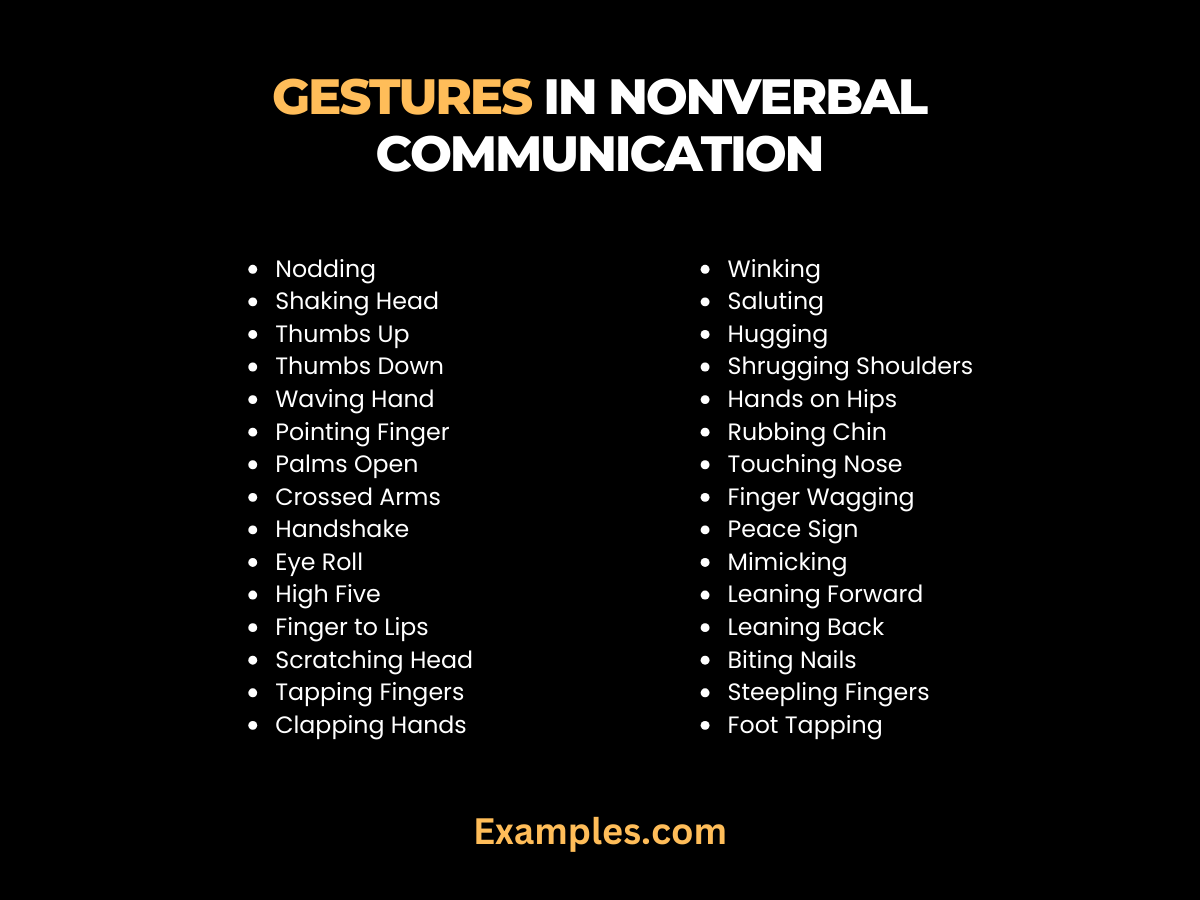
Nonverbal communication plays a crucial role in conveying emotions and intentions without words. Among its various forms, gestures in nonverbal communication and body language in nonverbal communication are paramount in expressing a wide range of feelings and messages. This article delves into 30 gestures that are integral to nonverbal communication, offering insights into their meanings and practical examples of their use in everyday interactions.
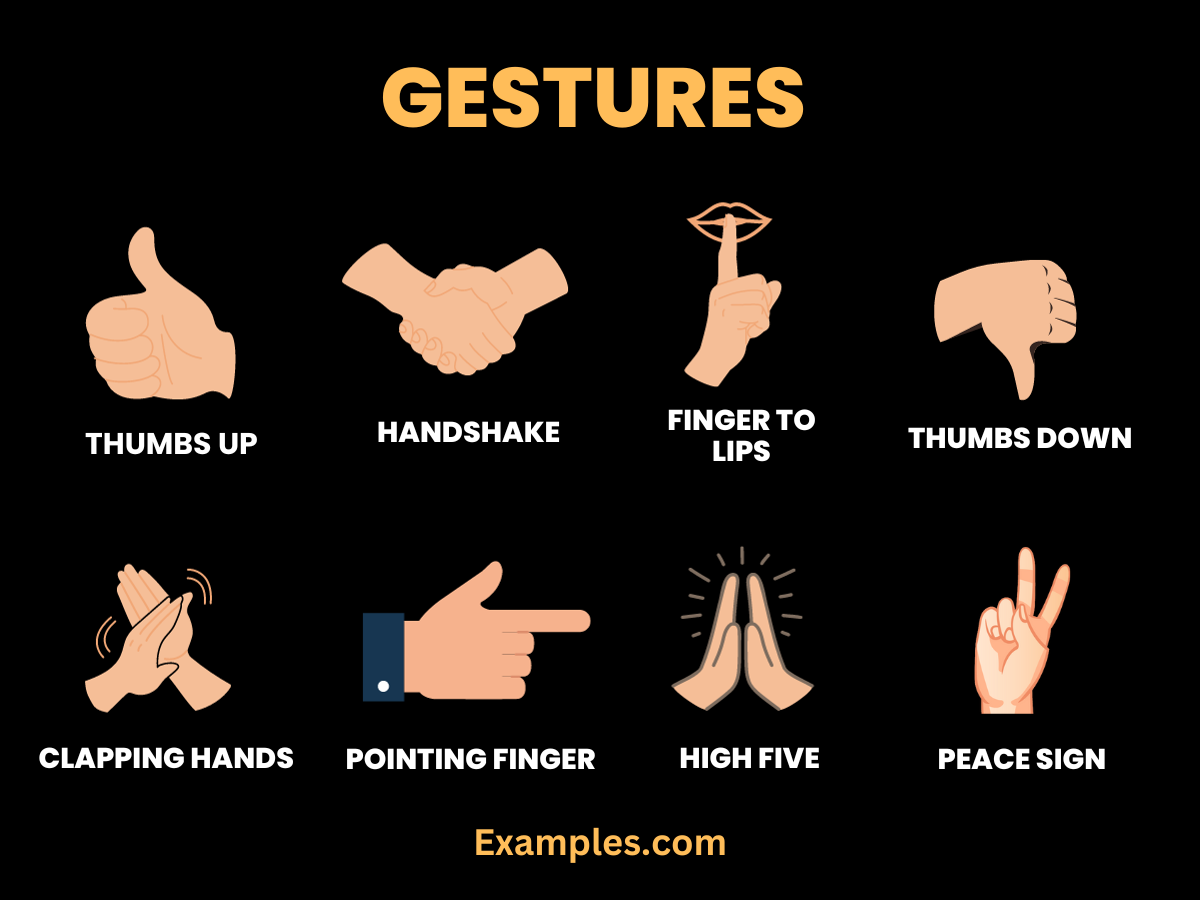
- Nodding: Indicates agreement or acknowledgment.
Example: When someone proposes an idea, nodding shows your approval without interrupting. - Shaking Head: Signifies disagreement or refusal.
- Example: Shaking your head during a discussion can silently express your disapproval.
- Thumbs Up: A universal sign of approval or doing well.
Example: Giving a thumbs up after a presentation boosts the presenter’s confidence. - Thumbs Down: Indicates disapproval or dissatisfaction.
Example: In response to a question, a thumbs down clearly shows disagreement. - Waving Hand: Used for greeting or saying goodbye.
Example: Waving at someone across the room is a friendly way to acknowledge their presence. - Pointing Finger: Used to direct attention.
Example: Pointing towards a door can nonverbally instruct someone to enter. - Palms Open: Signifies openness or honesty.
Example: Showing open palms can convey your transparent intentions in a conversation. - Crossed Arms: Often seen as a defensive or closed gesture.
Example: Crossing your arms during a debate might show you are unconvinced. - Handshake: Indicates agreement, greeting, or conclusion of an agreement.
Example: A firm handshake at the start of a meeting sets a positive tone. - Eye Roll: Expresses disbelief or irritation.
Example: Rolling your eyes can show your frustration in a light-hearted manner. - High Five: Sign of celebration or agreement.
Example: High-fiving a colleague after a successful presentation boosts morale. - Finger to Lips: Asking for silence or discretion.
Example: Putting a finger to your lips indicates the need for quiet in a library. - Scratching Head: Indicates confusion or the process of thinking.
Example: Scratching your head during a quiz shows you’re puzzled. - Tapping Fingers: Sign of impatience or thinking.
Example: Tapping fingers on a table can indicate you’re waiting for something. - Clapping Hands: Shows appreciation or agreement.
Example: Clapping after a performance is a universal sign of enjoyment. - Winking: Indicates a joke or inside knowledge.
Example: A wink can nonverbally say, “I understand what’s really going on here.” - Saluting: Shows respect or acknowledgment in a formal setting.
Example: Saluting a superior officer is a sign of respect in the military. - Hugging: Indicates affection or comfort.
Example: Hugging a friend offers comfort in times of distress. - Shrug Shoulders: Expresses uncertainty or lack of knowledge.
Example: Shrugging in response to a question shows you don’t know the answer. - Hands on Hips: Conveys readiness or aggression.
Example: Placing hands on hips during a debate can show your assertiveness. - Rubbing Chin: Suggests deep thinking or evaluation.
Example: Rubbing your chin while looking at an art piece shows contemplation. - Touching Nose: Can indicate doubt or secrecy.
Example: Touching your nose while speaking might suggest you’re hiding something. - Finger Wagging: Signifies disapproval or a warning.
Example: Wagging a finger at a child serves as a nonverbal caution. - Peace Sign: Symbolizes peace or victory.
Example: Flashing a peace sign can nonverbally communicate a positive attitude. - Mimicking: Copying someone’s gestures can indicate agreement or mockery.
Example: Mimicking a speaker’s gestures can show alignment with their ideas. - Leaning Forward: Shows interest or engagement.
Example: Leaning in during a conversation demonstrates your attentiveness. - Leaning Back: Can imply disinterest or relaxation.
Example: Leaning back in your chair might show you’re relaxed or disengaged. - Biting Nails: Indicates nervousness or anxiety.
Example: Biting your nails during an interview may reveal your nervousness. - Steepling Fingers: Represents confidence or authority.
Example: Steepling your fingers during a meeting displays confidence in your ideas. - Foot Tapping: Sign of impatience or nervousness.
Example: Tapping your foot rapidly can indicate you’re in a hurry or anxious.

Why are Gestures Important in Nonverbal Communication?
Gestures play a crucial role in nonverbal communication. They act as a visual language that often conveys more than words can. Gestures encompass movements made with the body, particularly hands and arms, which can express various feelings and thoughts. This silent language bridges communication gaps, making interactions more effective and meaningful. Here’s why gestures are so important:
- Enhancing Clarity and Understanding: Gestures can clarify or emphasize what is spoken, making the message more understandable.
- Expressing Emotions: They are a powerful tool for expressing emotions like joy, anger, or surprise.
- Cultural Significance: Gestures vary across cultures, offering insights into cultural nuances and aiding cross-cultural communication.
- Facilitating Memory and Recall: Visual cues from gestures help in better memory retention of the communicated message.
- Engaging the Audience: In presentations or speeches, gestures keep the audience engaged and interested.
- Replacing Verbal Communication: At times, gestures can completely substitute words, especially in situations where verbal communication isn’t possible.
Role of Gestures in Nonverbal Communication
Gestures form an integral part of nonverbal communication. Their role is multifaceted and extensive:
- Complementing: Gestures often complement verbal messages, providing a fuller picture of the communication.
- Substituting: They can substitute for words. For instance, a nod can replace the need to say “yes”.
- Regulating Conversations: Gestures play a role in regulating the flow of a conversation, signaling when it’s someone’s turn to speak.
- Accenting: They can accent or underline a specific part of the message, like pounding a fist to emphasize a point.
- Contradicting: Sometimes, gestures may contradict what is said verbally, revealing true feelings or thoughts.
- Illustrating: Gestures are used to illustrate or describe an idea or narrative, such as showing the size of an object.
- Revealing Personality Traits: Individual gesture patterns can reveal personality traits or emotional states.
Gestures in nonverbal communication are dynamic and context-dependent, influenced by cultural, social, and personal factors. Understanding and effectively utilizing gestures can enhance communication skills significantly.
Gestures, as a fundamental aspect of nonverbal communication, have the profound ability to complement, substitute, or even contradict spoken words, making them indispensable in conveying emotions and intentions. Their effective utilization can greatly enhance interpersonal communication, bridging language and cultural barriers.
To further explore the impact and importance of gestures in communication, the American Psychological Association (APA) provides extensive resources. Their website, APA, offers insights into the psychological aspects of nonverbal communication, including gestures, helping individuals understand the subtleties and complexities of human interactions.
Additionally, the National Communication Association (NCA) offers valuable resources for understanding various aspects of communication, including nonverbal cues like gestures. Their website, NCA, provides research, publications, and educational materials that delve into the nuances of communication, offering a deeper understanding of how gestures influence our daily interactions.
In conclusion, understanding and skillfully using gestures in nonverbal communication is crucial for effective interpersonal interactions. By leveraging resources from organizations like the APA and NCA, individuals can gain a more comprehensive understanding of the role of gestures in enhancing communication across diverse settings.



